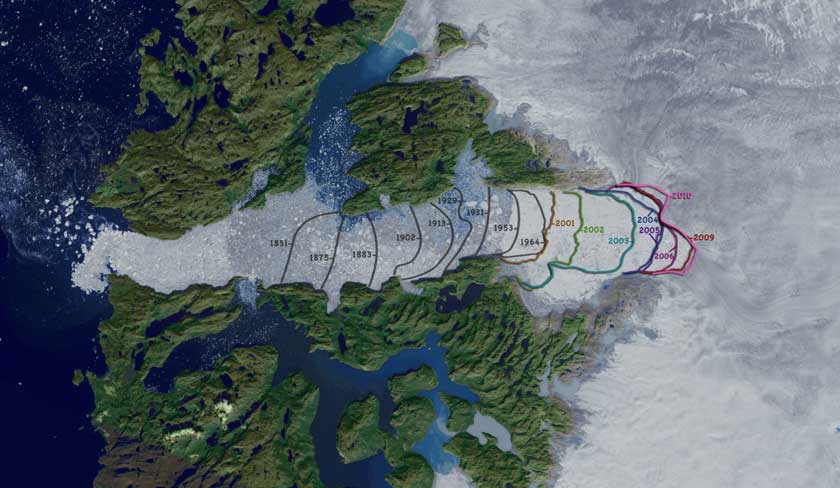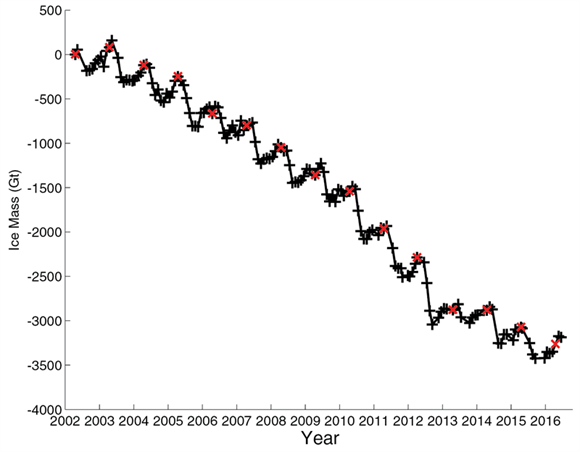The ice in Greenland is melting and that spells out trouble for humans. This is because there is enough ice in Greenland alone to raise sea level by roughly six meters.
So how much is melting?
Total Ice Mass
GRACE satellite gravity estimates obtained following Velicogna and Wahr (2014) and available since 2002, indicate that between April 2015 and April 2016 (the most recent period of available data) there was a net ice mass loss of 191 Gt (Fig. 3.4). This is about the same as the April 2014-April 2015 mass loss (190 Gt) and smaller than the average April-to-April mass loss (232 Gt) over the period of record. The trend of total ice mass loss for the 14-year is 269 Gt/yr.
That’s all old news. What prompts me to write is a new insight.
New Study: Bed elevation of Jakobshavn Isbræ, West Greenland, from high-resolution airborne gravity and other data
OK, so what is this about?
Basically gravity sensors were flown by helicopter across the Jakobshavnat glacier at low altitudes and low velocity. These accelerometers are a way of looking through the ice and seeing the actual subsurface.
What its known is that Jakobshavn Isbræ glacier in the west of Greenland has been speeding up and retreating, so the question was being asked as to why this was happening. The models exist, but without knowing what the underlying elevation was or for that matter how thick the ice was, using such models to be able to answer that was not possible. The data obtained via this study provides those answers now.
In essence, this is what they found …
From 1996-2016, the grounding line migrated at 0.6 km/yr from 700 m to 1,100 m depth. Upstream, the bed drops to 1,600 m over 10 km then slowly climbs to 1,200 m depth in 40 km. Jakob- shavn Isbræ will continue to retreat along a retrograde slope for decades to come.
The point is this – if the ice is thicker (and heavier), then it will move faster. If the ground underneath is bumpy, then the ice will slow down. This means that finding that it gets deeper as you up go upstream yields an insight into why the flow of ice has been speeding up.
Knowing the details now allows them to interpret things as follows …
First, they suggest that the grounding line may have been anchored on a 700-m sill in the 1990s, before retreating into a fjord about 400 m deeper. Following the rapid retreat until 2012, the glacier has reached a higher bed which slowed down the retreat temporarily, as projected by Joughin et al. [2012] despite uncertainties in prior bed mappings.
Second, during the retreat, as noted by Joughin et al. [2012], the glacier calving front has remained within 20 m of hydrostatic equilibrium. Ice front thickness will therefore increase from a current 1,100 m at km 12.5 (bed at 1,000 m depth) to 1,700 m when the glacier grounding line will reach at km 22 (bed about 1,500 m depth) or 50%, which will increase the ice discharge accordingly.=
Third, the results confirm that there is not major bed obstacle that could slow down the retreat at least until km 30.
Fourth, the grounding line is currently 400 m deeper than estimated previously, hence thermal forcing from the ocean is 0.4oC greater from the pressure dependence of the freezing point of seawater alone.
To distill that down – there is going to be a fast retreat of the glacier in the coming years and decades.

The real challenge here is that even if we did everything that we think is necessary to start to address climate change, this it is not going to stop anytime soon.
